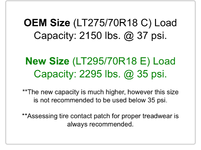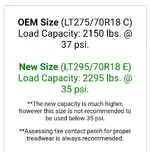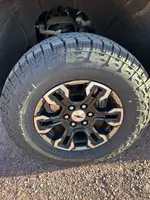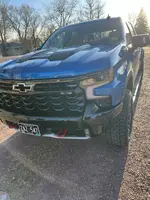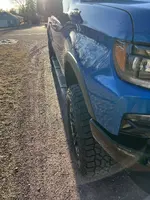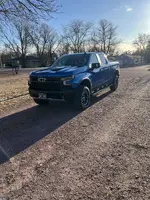Navigation
Install the app
How to install the app on iOS
Follow along with the video below to see how to install our site as a web app on your home screen.
Note: This feature may not be available in some browsers.
More options
Style variation
You are using an out of date browser. It may not display this or other websites correctly.
You should upgrade or use an alternative browser.
You should upgrade or use an alternative browser.
ZR2 Oversize Tires Thread
- Thread starter wutang61
- Start date
- Nov 22, 2023
- 910
- 2,782
Just thought it interesting that GM changed their recommendation on basically the same truck and tire setup.View attachment 18018
Based on what’s written on my 22.
YMMV but from my experience I don’t recommend this. E’s need pressure.
- Feb 21, 2023
- 5,343
- 12,599
Interesting, cause my 22 says 38......I think.FWIW the placard on my 2022 said 35 psi while the placard on my new 2025 says 38 psi.
I run my Toyo RT Trails Load Range E 10 PR at 37-38.psi cold and they run up to 40+ psi warm and they feel pretty good.
Last edited:
- Feb 21, 2023
- 5,343
- 12,599
I got a strange number when I punched mine in too. Max load on the Toyo RT Trails says 4080 psi at 80 psi. They feel sluggish under 37-38 cold.View attachment 18018
Based on what’s written on my 22.
YMMV but from my experience I don’t recommend this. E’s need pressure.
Attachments
- Oct 8, 2024
- 236
- 563
Looks like the half ton has a GVW of 7,300 lbs. At 35 psi the tire load rating is 9,180 lbs. While you could drop a little lower for comfort and still have coverage for load if you really wanted too, the calculator is normally a good starting point. It is taking the load charts, calculating the OEM load and converting it to the load table for your new size. OEM pressure is normally a balance of comfort and efficiency.I got a strange number when I punched mine in too. Max load on the Toyo RT Trails says 4080 psi at 80 psi. They feel sluggish under 37-38 cold.
A chalk test of tread contact is normally a good thing to do, and the calculator does recommend that, even tread contact will maximize the miles you can get out of the tires. I've found I normally see a decent tread pattern at the calculator, resulting in solid wear.
After that it's up to your preference, the lower the pressure the softer the ride, the higher the pressure the firmer the ride. When you get outside the sweet range for tread contact on the low range you can get stability issues and outer tread wear, when you go higher, contact patch shrinks to the crown of the tire, giving less drag and normally better MPG, but tends to center wear the tire.
Changing from the stock tires to a wider, more aggressive tire will feel more drag, because that's increased traction is the point of the wider tire.
A well damped, compliant, independent suspension reduces the need to use tires as the cushion on road. As nice as the 2500 suspension, It's not real surprising that upping the pressure doesn't make the half ton ride harshly and helps with efficiency and stability.
- Feb 21, 2023
- 5,343
- 12,599
I run mine from 12 to 80 psi. I usually start with mfg recommendations and then go up and down +3 and decide where to run them.
I've never had a bad tire on a vehicle due to wear. I've never changed a tire on the road side. I've plugged a couple from screws/nails.
My camper likes to chew through them, but it should have been a triple axle. I had to change a tire on that once as the tread separated just as I got to my campsite.
I've never had a bad tire on a vehicle due to wear. I've never changed a tire on the road side. I've plugged a couple from screws/nails.
My camper likes to chew through them, but it should have been a triple axle. I had to change a tire on that once as the tread separated just as I got to my campsite.
- Jan 29, 2023
- 241
- 740
Chevyman2022
Founding Member
- Sep 18, 2021
- 32
- 63
Got my new shoes on. I went with stock tire size 275/70r18 Falken wildpeaks 4w. 1 1/2” spacers all around. Had to trim the inner weather tech mudflaps about 3” square.
Attachments
Similar threads
- Replies
- 11
- Views
- 3K
- Replies
- 10
- Views
- 6K
